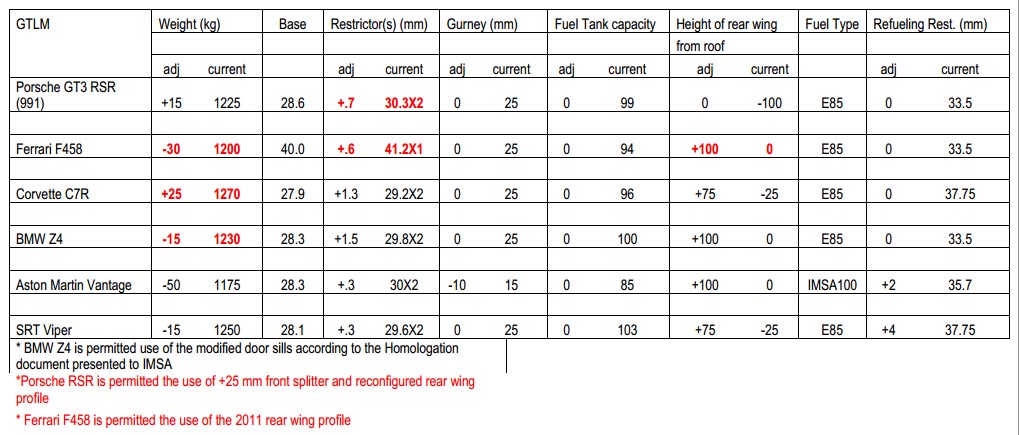|
|

|
Not already registered? Register here. |
|
|
|
|
|
|  | | July 29 2014 11:06:08 PM EST | |
| In the world of sportscar racing, you hear the term "BoP" a lot. "BoP" is an acronym for Balance of Performance. Some series call it different things, but it is all the same. Some fans that may not follow the series as hardcore as others may not know what it is or how it works.
Here we will explain everything as it relates to the GTE/GTLM class in the Tudor United Sports Car Championship and the ACO related series around the globe such as the World Endurance Championship. Note: Other racing series or other classes may vary in how they do their BoP.
DEFINITION:
Balance of Performance is the ongoing adjustment of a cars performance in relation to other cars, on a case by case basis, to allow for close competition throughout the class.
WHY IS IT NEEDED:
1) Close on track performance - In the GTE/GTLM class we have Corvette, Porsche, BMW, Viper, Ferrari, and Aston Martin. Front engine, rear engine, and mid-engine configurations. All different answers to the same set of regulations. These manufactures spend upwards of 8 figures ($xx,xxx,xxx) to develop, run, be competitive, and hopefully win, all in the name of advertising and hopes that you will buy a vehicle from them when the time comes. All they want is a fair shot at their competition.
2) Cost Reduction - When the performance bar is level, it prevents an "arms race" to see who can bring the bigger and better each weekend until the competition can't afford to keep up.
3) Entertainment Value - Fans don't like watching the same cars dominate race after race. Teams/drivers also like to know they stand a chance any given weekend.
WHO MAKES THE CALL:
The sanctioning body of the series makes the decisions on how and when to change the BoP.
The ACO is the sanctioning body for the GTE Class in the WEC, which includes the 24hrs of Le Mans. The GTE class (GTLM in the US) regulations are also made by the ACO
(Automobile Club de l'Ouest).
IMSA is the sanctioning body for the GTLM Class in the Tudor United Sports Car Championship. The regulations are the same as the ACO's class, but IMSA applies their own BoP. For the most part, any time an IMSA team, such as Corvette Racing, goes to Le Mans the BoP is adjusted based on the ACO BoP. IMSA has no say on BoP outside of the American series. There have been some exceptions in the past, such as the Vipers in 2012, where the ACO did not have enough data to calculate their own BoP, so they used IMSA's restrictor size.
WHAT IS ADJUSTED:
1) Weight - 1245kg is the baseline vehicle weight for the GTE/GTLM class per the FIA/ACO rules & regulations.
2) Sonic Air Restrictors - Each car/engine is unique. There is no "baseline" for restrictor size. 1 or 2 restrictors may be used depending on the number of intakes.
3) Gurney - Gurney is the vertical flap on the trailing edge of the wing.
4) Fuel Tank Capacity - 90L is the max capacity per ACO regulations. IMSA allows larger fuel cells to address the issue of class separation. Plastic balls of different volumes are placed in the fuel cell to adjust the capacity.
5) Rear Wing Height - Wing height is measured from the tallest point of the roof. Baseline is 0mm.
6) Refueling Restrictors - Depending on fuel tank capacity, restrictors are changed on the fuel rig to adjust fuel flow, as to not disadvantage anyone during refueling.
7) Any other technical modification that the sanctioning body may deem necessary
HOW ARE ADJUSTMENTS DETERMINED:
Each car has a mandatory performance data recorder. After each event, all performance data is downloaded and given to the series officials. Any information required by the series in order to achieve these adjustments must be supplied by the competitors. Any competitor who deliberately gives false information, or attempts to influence the adjustment process may be given a sanction. Changes are not subject to protest or appeal.
IMSA also relies on public timing loop data for a large part of its analysis. This keeps the process transparent and allows the teams, fans, and manufactures to have the same data as the series to calculate BoP.
BoP data is always taken from the race, not qualifying.
The fastest average lap time is calculated using the number of laps which corresponds to 20% of the race distance.
BoP is also calculated for each model homologated, not per team. Example: All teams running a 2014 Porsche 911 RSR will receive the same BoP. At the same time, if there are any teams running a different homologated year or evolution of the type, a separate BoP can be issued.
HOW ARE TEAMS NOTIFIED:
Transparency is key. The sanctioning body has extensive conversations with the manufactures prior to the release of any BoP changes.
The sanctioning body will then issue a public release of the information in a Competition Bulletin. The manufactures all know what is coming prior to the release of the bulletin. These bulletins are publicly available to view online.
IMSA Competition Bulletins
FIA/ACO Competition Bulletins
We want to thank IMSA's Vice President of Competition and Technical Regulations Scot Elkins for helping us fact check this article and give us some insight into the process.
|
| |